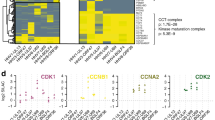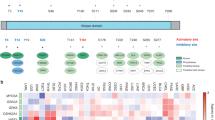Abstract
CYCLINS are proteins synthesized during each cell cycle and abruptly destroyed in each mitosis1–5. Cyclins have been implicated in the induction of mitosis6,7 and are associated with the serine–threonine protein kinase p34cdc2 as components of mitosis promoting factor (MPF)8–-10. On the basis of conserved sequence motifs cyclins can be divided into A or B types. We recently cloned a human cyclin B (ref. 11) and showed that cyclin B expression is regulated transcriptionally and post-translationally during the cell cycle, and that cyclin B associates with p34cdc2. Here we report that human cyclin A messenger RNA and protein levels also vary during the cell cycle, and increase and decrease in advance of cyclin B levels. Cyclin A is associated with a protein of relative molecular mass 33,000 that is related to, but distinct from, p34cdc2, and this complex has histone H1 kinase activity in vitro. Cyclin A is identical to p60, a protein that associates with p34cdc2 in interphase cells12 and with adenovirus E1 A in transformed cells22.
This is a preview of subscription content, access via your institution
Access options
Subscribe to this journal
Receive 51 print issues and online access
$199.00 per year
only $3.90 per issue
Buy this article
- Purchase on Springer Link
- Instant access to full article PDF
Prices may be subject to local taxes which are calculated during checkout
Similar content being viewed by others
References
Evans, T., Rosenthal, E. T., Youngblom, J., Distel, D. & Hunt, T. Cell 33, 389–396 (1983).
Swenson, K., Farrell, K. M. & Ruderman, J. V. Cell 47, 861–870 (1986).
Standart, N., Minshull, J., Pines, J. & Hunt, T. Devl Biol. 124, 248–258 (1987).
Westendorf, J. M., Swenson, K. I. & Ruderman, J. V. J. Cell Biol. 108, 1431–1444 (1989).
Hunt, T. Curr. Opin. Cell Biol. 1, 286–274 (1989).
Minshull, J., Blow, J. J. & Hunt, T. Cell 56, 947–956 (1989).
Murray, A. W. & Kirschner, M. W. Nature 339, 275–280 (1989).
Draetta, G. et al. Cell 56, 829–838 (1989).
Labbé, J.-C. et al. EMBO. J. 8, 3053–3058 (1989).
Gautier, J. et al. Cell 60, 487–494 (1990).
Pines, J. & Hunter, T. Cell 58, 833–846 (1989).
Giordano, A. et al. Cell 58, 981–990 (1989).
Lehner, C. F. & O'Farrell, P. H. Cell 56, 957–968 (1989).
Hanks, S. K. Proc. natn. Acad. Sci. U.S.A. 84, 388–392 (1987).
Wang, J., Chenivesse, X., Henglein, B. & Brėchot, C. Nature 343, 555–557 (1990).
Minshull, J. et al. in Cell Cycle Control in Eukaryotes (eds Beach, D., Basilico, C. & Newport, J.) 128–139 (Cold Spring Harbor Laboratory, New York, 1988).
Luca, F. C. & R uderman, J. V. J. Cell Biol. 109, 1895–1909 (1989).
Gould, K. L. & Nurse, P. Nature 342, 39–45 (1989).
Pondaven, P., Meijer, L. & Beach, D. Genes Dev. 4, 9–17 (1990).
Pines, J. & Hunter, T. New Biologist 2, 389–401 (1990).
Richardson, H. E., Wittenberg, C., Cross, F. & Reed, S. I. Cell 59, 1127–1133 (1989).
Harlow, E., Whyte, P., Franza, B. R.,& Schley, C. Molec. cell. Biol. 6, 1579–1589 (1986).
Whyte, P. et al. Nature 334, 124–129 (1988).
De Caprio, J. A. et al. Cell 58, 1085–1095 (1989).
Author information
Authors and Affiliations
Rights and permissions
About this article
Cite this article
Pines, J., Hunter, T. Human cyclin A is adenovirus E1A-associated protein p60 and behaves differently from cyclin B. Nature 346, 760–763 (1990). https://doi.org/10.1038/346760a0
Received:
Accepted:
Issue Date:
DOI: https://doi.org/10.1038/346760a0
This article is cited by
-
Regulatory miRNAs, circRNAs and lncRNAs in cell cycle progression of breast cancer
Functional & Integrative Genomics (2023)
-
FMR1NB Involved in Glioma Tumorigenesis Is a Promising Target for Prognosis and Therapy
Current Medical Science (2022)
-
CDK1 structures reveal conserved and unique features of the essential cell cycle CDK
Nature Communications (2015)
-
Cell cycle staging of individual cells by fluorescence microscopy
Nature Protocols (2015)
-
Cyclin A and cyclin B1 overexpression in differentiated thyroid carcinoma
Medical Oncology (2012)
Comments
By submitting a comment you agree to abide by our Terms and Community Guidelines. If you find something abusive or that does not comply with our terms or guidelines please flag it as inappropriate.



